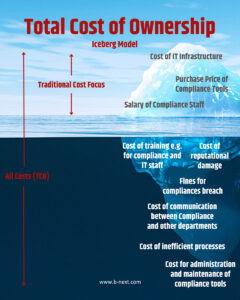Can you afford to overlook the total cost of compliance?

As participants in global financial markets navigate stormy economic conditions, not a day goes by without news of increasing interest rates and costs. Inflationary pressure and escalating expenses may tempt participants to overlook the long term cost of compliance in favour of short-term fixes. However, it is precisely during such uncertain times, that such temptation should be resisted. More than ever, the total cost of ownership (TCO) of compliance requires even closer scrutiny and long-term planning to protect your reputation and your bottom line.
The researchers Gartner, define TCO as a “comprehensive assessment of information technology or other costs across enterprise boundaries over time”[1]. We believe a TCO assessment of compliance systems can be the key to finding calmer waters and future stability, protecting you against unforeseen risks and safeguarding your future commercial interests. This approach can also help reduce the long term cost of owning and maintaining regulatory compliance solutions. We will explore some of the strategic issues that leadership teams should consider when evaluating the total cost of compliance systems and factors to consider when assessing TCO in compliance.
What are the real cost drivers of compliance?
Over the course of more than thirty years in the fields of compliance and trade surveillance, we have observed a lack of understanding of the cost drivers of compliance. Often perceived as a cost centre, there has been a historical tendency to keep compliance costs to a minimum. It is therefore unsurprising at times of economic stress, that such a mindset stiffens and reliance on existing manual or inefficient processes continues unchanged. However, this exposes you to hidden costs that may only become apparent when an unexpected compliance breach strikes.
The consequences of such a breach can be serious and costly. When we evaluate legacy compliance systems and find manual and unstructured processes, we know from experience they can be highly prone to errors. This can lead to failed compliance, resulting in a manifold exposure to unforeseen costs. These might include fines by the regulator, significant reputational damage and incorrect payments made to counterparties. So, what factors should you consider when assessing TCO in compliance?
Factors to consider when assessing TCO in compliance
We acknowledge the total cost of financial compliance and have commented previously on its complexity. The regulatory agenda is subject to continual and often rapid change as it responds to new threats to the financial markets. Compliance systems therefore require ongoing investment and must be fit for the future.
Innovation and TCO built-in
Compliance must be capable of evolving to match future regulatory change, as well as adapting to powerful emerging technologies such as Artificial Intelligence (AI). As a partner trusted by some of the world’s most respected institutions, we believe TCO must be built in to compliance solutions. We innovate continuously to develop cost effective solutions that help our customers to stay ahead of change and mitigate against risk over the long term.
We see compliance as a platform where different modules are integrated to monitor specific areas of compliance such as trade surveillance, conflict of interest and insider dealing. These modules automate compliance processes and are integrated under a single holistic compliance platform that is cloud hosted and created from the outset with Total Cost of Ownership and cost effectiveness in mind. Automating and standardizing time consuming and repetitive compliance processes has the added benefit of reducing the errors that can lead to fines and reputational damage.
A holistic platform
A holistic platform streamlines, harmonises and reduces the complexity of compliance systems. This makes it easier and more cost effective in the long term, to add functionality for the inevitable new compliance requirements that regulators mandate. A cloud-based hosting model for the platform, helps control the total cost of , because it enables a “pay only for what you actually use”- approach.
Such holistic solutions can capture and analyse vast amounts of data and this can uncover valuable data treasure of benefit to your organization and customers.
This all helps to future-proof compliance systems while optimizing the TCO of the system over the long term.
What does the future hold for TCO in compliance?
Compliance is a long game, a short term approach or one that overlooks the total cost of compliance can store up problems for the future. By considering the hidden costs and long term TCO implications of compliance, you can ensure you select an optimised solution that protects your organization against the risks of non-compliance and changing regulatory demands.
As regulators increase their scrutiny of financial markets and mandate further compliance, the shortcomings of manual based compliance systems will become more obvious. The long term cost of compliance will also become difficult to ignore. We believe this will accelerate the shift towards automated, platform-based holistic solutions.
In the future we also expect AI tools will be used to help analyse the large amounts of data captured by compliance platforms. This will help reduce the complexity of compliance, increase cost transparency and lead to reduced cost of ownership over time. What is more, the new insights revealed by data analysis will enable profit centres within the business to generate profits more sustainably. This will transform the perception of compliance from a cost centre, to a business centre that pays its own way; an opportunity few will want to overlook.
[1] https://www.gartner.com/en/information-technology/glossary/total-cost-of-ownership-tco